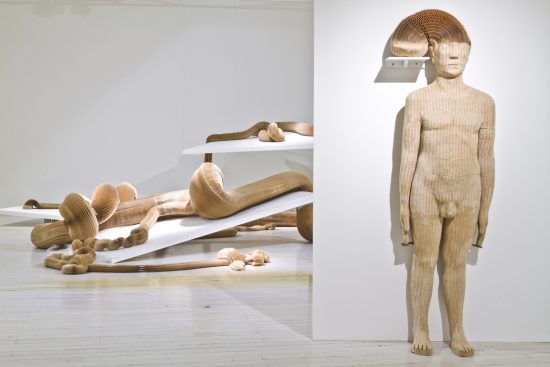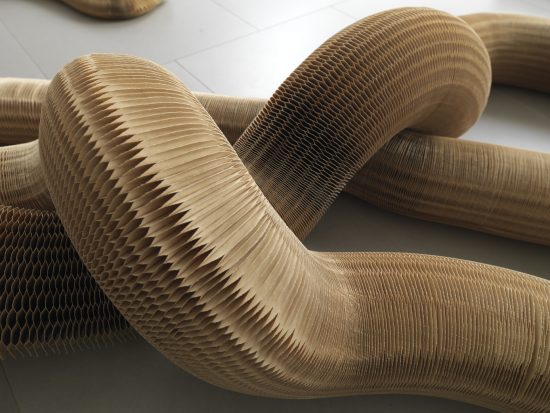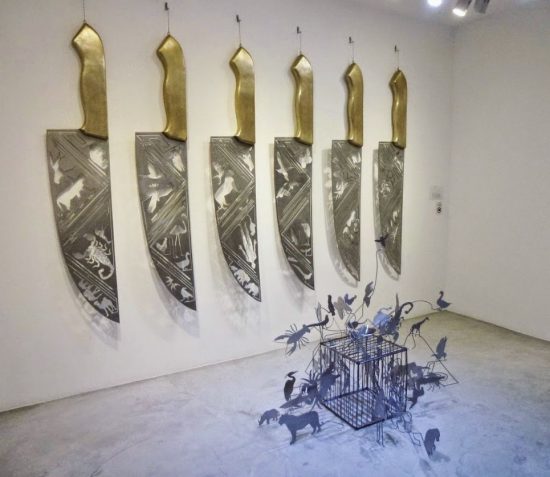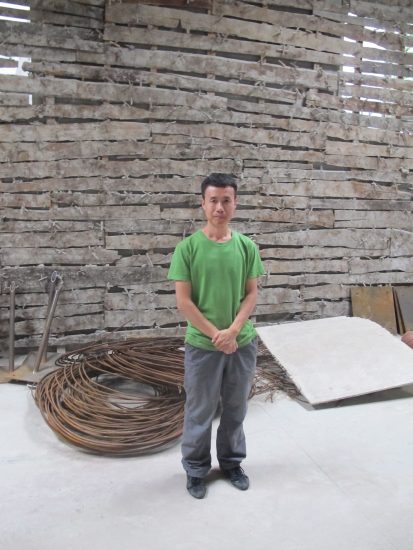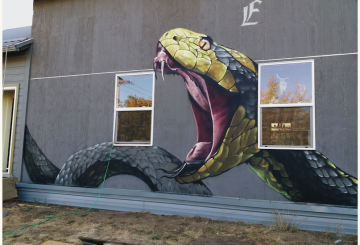As a little boy in rural Jilin Province, in China’s far north-east –– closer to North Korea and Russia than to Beijing –– Li Hongbo made his own simple playthings from paper, taking pages out of school exercise books to construct toy planes, trucks and trains. Now, as an artist working in Beijing, exhibiting across the globe, he is known for extraordinary large-scale installations such as the two life-sized expanding figures held in the White Rabbit Collection, or ‘Ocean of Flowers’, an installation of brightly-coloured paper guns and weaponry seen on Cockatoo Island at the 18th Biennale of Sydney in 2012. The intimacy of handling paper resonates with childhood memories of folk art traditions and his own hand-made toys. Today, having mastered the art of cutting, gluing and carving thousands of sheets of cheap brown paper to transform this humble material into intricately designed kinetic forms, Li Hongbo says that what he enjoys most, apart from the endless possibilities of the medium, is its accessibility. He believes that Chinese people have a special bond with paper that comes from a deep cultural memory.
Li Hongbo, Paper, 2010, dimensions variable, image courtesy White Rabbit Collection
Li’s concertina-like expandable sculptures begin as stacks of paper; until they are stretched and pulled into new shapes they appear as if carved from stone or wood. As a student Li Hongbo researched how paper was used in Chinese folk art, influenced by the significant artist and teacher, Lü Shengzhong, who revived a Chinese craft tradition with his own contemporary papercut installations. Lü’s emphasis on the importance of folk art inspired his students to undertake field research in remote areas of rural China, recording obscure and endangered arts and crafts and learning their techniques. Returning to Beijing, Li Hongbo and his contemporaries sought new ways to embed these traditions into their own art practice: Li experimented with the Chinese ‘honeycomb’ paper folding technique.
In late 2015, I spoke with Li Hongbo in his Beijing studio and asked him what it is about paper that he finds so endlessly fascinating. What follows is an edited extract of that conversation:
Li Hongbo: Firstly, it is because it is very cheap and very common, and accessible to everyone. And it is everywhere, it has a special bond with people. Secondly, Chinese traditional culture has a lot to do with paper. It’s about cultural memory and tradition. People have never stopped their investigation into the endless possibilities of paper. I love paper.
Luise Guest: When, and how, did your interest in the magical possibilities and properties of paper originate?
LH: When we were little a lot of toys were made of paper; toys at that time were very expensive so children would use paper to make things like aeroplanes. They would even tear their textbooks to use that paper to make toys. My handmade toys were very popular with my classmates so I had very good relationships with them! Then later I was a book designer, and I also studied ancient Chinese Buddhist books and wood block printing. So, paper was created long before the Tang Dynasty – more than 4000 years ago – and when I studied the ancient traditions and religious paintings I discovered that paper was a medium that carried history and carried stories. All of this led to my fascination with the endless possibilities of paper.
LG: How did you develop the skills needed to make these extraordinary sculptures?
LH: Originally, I studied Chinese folk art and I am also an expert on Chinese paper culture. The ancient Chinese were very clever; they could make various toys with one sheet of paper that can take various forms. So, I learned how to make my own works in this traditional way.
LG: Is this ‘honeycomb’ gourd technique that you use similar to the method used to make traditional lanterns?
LH: Yes, very much so.
LG: Can you tell me a little about your background – your childhood and student years in Jilin Province before you came to Beijing? I am curious to know about your earliest experiences of art.
LH: When I was young I was very naughty and I liked making toys with my own hands – toys were very expensive so my parents would not buy me toys, and I became very good at it. I liked painting, so I grew very confident in these things. I never stopped painting. At Spring Festival in 2013 I discovered that my mother had collected every artwork I had made since I was a small child, from primary school to college. All of those exercise books were filled with sketches and drawings – but very few notes! In senior high school, I began to learn things and in college I majored in art education. I did not work as a teacher, though, because I wanted a career as an artist, so after graduation I came to Beijing. [In Beijing, Li completed two Masters Degrees at the Central Academy of Fine Arts, in Folk Art and in Experimental Art, over a period of ten years.]
Li Hongbo, Paper, detail.
Paper (2010) at first seems to consist of solidly sculpted figurative forms. Two life-sized naked men stand straight, hands held stiffly at their sides, recalling Archaic Greek ‘kouros’ figures. This was one of the first fully realized sculptures Li Hongbo made using the ‘paper gourd’ technique. The first experimental figure took six months to complete; the second was finished in three months. Gourds were considered to have ritual, almost magical properties in Daoism: the shape of the fruit represents the sky and the earth, the infinite universe, and is a portal through which the Immortals could travel. Their name in Chinese signifies good luck, health and prosperity, and in many parts of China people still make brightly coloured paper gourds to hang from the roofs of their houses during festivals. Many layers of paper are glued together to make expandable, net-like forms that can be cut into the required shapes. Li Hongbo uses this technique, in a more ambitious and complex way, to create male and female figures and sculptural busts. Carpentry tools, an angle grinder, and sandpaper then release the sculptural form from its block of thousands of glued sheets of paper.
These sculptures take on entirely new forms when the apparently stable objects and figures are activated, stretched out like a concertina. Objects that seemed solid are magically unpredictable, capable of expansion and contraction, creating new relationships with the spaces they inhabit. The two figures that make up Paper literally stretch the bounds of normality. When compressed, the paper men look as if they are carved from wood or stone. Made of almost ten thousand layers of paper, they can be expanded and pulled into bizarre configurations, their elongated arms and legs twisting and tumbling across the gallery floor to occupy the entire room. The intact, compressed figure juxtaposed with a stretched, apparently boneless one, its long limbs writhing through the gallery, suggests that humanity’s potential is limitless.
Li Hongbo, Shadow of Knives – You Reap What You Sow, 2014, metal, dimensions variable, image courtesy White Rabbit Collection
LG: What kind of sculptures were you making while you were studying at the Central Academy of Fine Arts?
LH: I would go to very remote Chinese villages during the master’s degree in Chinese folk art, [and] I would see for myself how those illiterate people understand their own culture. They are the grassroots people with a very unique understanding of their own culture. I did a lot of field research and I continued that for about a decade. It was during my study in the Experimental Art Department that I became aware of western experimental art. So [I went] from the most basic grass roots culture to the most modern. And I discovered a lot of similarities, for example with the Buddhist wood cut prints: when printing came into being it was very pioneering and then 500 years later it had become very traditional. So modern art is the same: when it first appears, it is very new and then years later it is outdated and has only historical value. But both [kinds of art practice] are about people’s faith and their common humanity… I am not a conceptual artist; I am just an art practitioner.
Li Hongbo in his Beijing Studio, 2015, photograph Luise Guest, courtesy White Rabbit Collection
In a surprising departure from paper the Shadow of Knives series (2014) once again takes an everyday object as the starting point. Li carves the forms of people and animals from the razor-sharp blades of the knives found in every Chinese kitchen. Shadow of Knives: You Reap What You Sow (2014) consists of six enormously over-scaled knives hanging on the wall: terrifying cleavers for giants. Cut from their blades is a menagerie of creatures, great and small — scorpions and dragonflies, crayfish, ducks, geese, a flamingo, a lion, a rhinoceros, a giraffe and an elephant now exist as absences, their silhouettes excised from the metal blade. A human figure is suspended upside down as if descending into the underworld. We think of the cruelties enacted upon animals, the needless hunting, the scientific experiments, the horrors of industrial scale farming; all the ethical and environmental dilemmas that we now face are here represented in sharp relief.
This dark humour is amplified in smaller works, such as Shadow of Knives: Hunting (2014), where a delicate, spindly tree and the ominous figure of a man aiming a rifle have been cut from the blade of a cleaver. This series recalls the intricate paper-cuts of Chinese folk tradition. Shadow of Knives: Desire (2014), depicting a line of tiny running men cut from the blade and dashing towards an unknown destination, and Shadow of Knives: Wasteland (2014), with its human skeleton looming over a stunted tree, make the artist’s despair at the excesses of the contemporary world abundantly clear. Always humble, Li Hongbo believes art should reflect people’s faith and their common humanity. He says, ‘I am not a conceptual artist, I am just an art practitioner.’
In the interests of full disclosure, Luise Guest is the Manager of Research for the White Rabbit Collection of contemporary Chinese art. It was in this capacity that she spoke with Li Hongbo in Beijing in October 2015, whilst researching artists in the collection. Li Hongbo’s ‘Paper’ was shown at White Rabbit Gallery in ‘The Big Bang’ in 2010, and in ‘Double Take’ in 2012.
